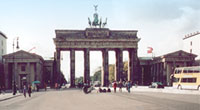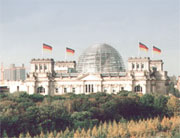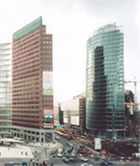Walk 'n' Talk Tours
We can provide you with one of our customised Walk
'n Talk Tour s which focus on the aspects of
the city that interest you. What follows are examples of what
you might do.
The Berlin Wall - from Brandenburg Gate to Checkpoint Charlie
The tour starts at Brandenburg Gate - a former symbol of the German
Division on account of its location on the borderstrip that divided
East- and West-Berlin and a symbol of German Unity today. The
guide will walk with you along the former inner-city border and
give background information on why the Berlin Wall was put up
in 1961, how the border system worked and how it affected people.
 You
will go past the new urban development at Potsdamer Platz / Leipziger
Platz and discover remaining sections of Berlin Wall and a remaining
watchtower. The tour also leads past Martin-Gropius-Bau, Berlin
City Parliament (occupying the old Prussian Parliament building)
and "Topography of Terror". It ends at former Checkpoint Charlie,
where the guide describes in detail what happened in the dramatic
days of October, 1961, when American and Soviet tanks faced each
other here - fortunately the situation did not escalate any further. You
will go past the new urban development at Potsdamer Platz / Leipziger
Platz and discover remaining sections of Berlin Wall and a remaining
watchtower. The tour also leads past Martin-Gropius-Bau, Berlin
City Parliament (occupying the old Prussian Parliament building)
and "Topography of Terror". It ends at former Checkpoint Charlie,
where the guide describes in detail what happened in the dramatic
days of October, 1961, when American and Soviet tanks faced each
other here - fortunately the situation did not escalate any further.
The total tour time is 1,5 hours. It is possible to visit the
Wall Museum at Checkpoint Charlie afterwards.
Tour of the historical centre of old Berlin
The famous boulevard of old Berlin "Unter den Linden" (Under the
Linden trees, 1,4 km long) offers a fascinating selection of old
architecture: e. g. the Old Arsenal of the Royal Prussian Army
(today German History Museum), the German State's Opera, Humboldt
University, Catholic St. Hedwig's Cathedral, and this is only
the most prominent buildings. The guide will give detailed information
on prominent buildings and their backgrounds.
 The
guide will take you inside a number of buildings - let yourself
be surprised! The tour will also lead to Paris Square with Brandenburg
Gate, the main symbol of Berlin, and to the square "Gendarmenmarkt"
with its magnificent buildings from the 18th and 19th century.
On nearby Friedrichstraße there is the fashionable new shopping
arcade "Friedrichstadtpassagen" and the Berlin branch of Galeries
Lafayettes, inaugurated in 1996. The impressive Berlin Cathedral
(Berliner Dom) and the neighboring Museum Island will be described.
Its collections are included in UNESCO's list of World Cultural
Heritage. The
guide will take you inside a number of buildings - let yourself
be surprised! The tour will also lead to Paris Square with Brandenburg
Gate, the main symbol of Berlin, and to the square "Gendarmenmarkt"
with its magnificent buildings from the 18th and 19th century.
On nearby Friedrichstraße there is the fashionable new shopping
arcade "Friedrichstadtpassagen" and the Berlin branch of Galeries
Lafayettes, inaugurated in 1996. The impressive Berlin Cathedral
(Berliner Dom) and the neighboring Museum Island will be described.
Its collections are included in UNESCO's list of World Cultural
Heritage.
The required time for a walking tour of the historical centre
of Berlin is between 2 and 3 hours.
 Hackesche
Höfe and the historic Jewish Quarter of Berlin Hackesche
Höfe and the historic Jewish Quarter of Berlin
In the northern section of Berlin-Mitte (Berlin's central district)
there is one of the liveliest quarters of the city with many restaurants
and cafés, clubs and bars. Several old building complexes (late
19th century/early 20th century) grouped around a varying number
of courtyards ("Höfe") have been recently renovated and become
attractive locations for galleries, fashion designers and restaurants
as well as for small theaters. The "Hackesche Höfe" (Hacke Courtyards)
in particular enjoy enormous popularity. There is a multi-faceted
nightlife in the whole area.
At the same time, the area around Oranienburger Straße and Hackescher
Markt, in eastern direction to Rosa-Luxemburg-Platz, is the main
Jewish Quarter of old Berlin. Today, there is a revival of Jewish
life in Berlin, and on the preserved front section of the beautiful
New Synagogue of 1866 (now a Jewish Community Centre), the gilded
dome, 50 metres tall, has been reconstructed authentically in
1991. There are other sights and many stories as well, and the
guide on this tour will take you to interesting back yards that
you might have overlooked on your own.
The required time for a walking tour as described is between
2 and 3 hours.
 Berlin,
the German capital Berlin,
the German capital
When Germany was re-unified in 1990, Berlin was made its capital.
By 1999, the major institutions of Parliament and Government had
been relocated from Bonn to Berlin. On the tour, the guide will
explore with you the main Government Quarter also referred to
as the "Spreebogen" (because it is an area neighboring a marked
river bend of Spree river). The guide will shed light on the past
and present of the area as well as of the government institutions
and their functioning. The development of the urban design for
the new Government Quarter will be explained. You will stand in
front of the Reichstag building - it contains the new plenary
hall of German Parliament "Deutscher Bundestag" - and learn more
about its spectacular new glass dome, designed by the famous British
architect Lord Norman Foster. You will look at the parliamentary
office quarters Paul-Löbe-Haus, Marie-Elisabeth-Lüders-Haus and
Jakob-Kaiser-Haus. Discover the "Reichstagspräsidentenpalais"
(that is the old building which was formerly the seat of the Chairman
("President") of the old parliament "Reichstag"), the new kindergarten
of the Government Quarter, and the Swiss Embassy.
The guide will relate the overall urban design concept "Band
des Bundes" (Federal Belt), that has been (partly) realized according
to plans of the Berlin-based architects Axel Schultes and Charlotte
Frank. The same architects designed the new Chancellory, seat
of the German Chancellor (head of government) - which is located
in the Spreebogen as well.
The tour takes between 1,5 and 2 hours. It is possible to include
in the walking tour visits to nearby Paris Square with Brandenburg
Gate, and to the former main street of government Wilhelmstraße.
This requires additional time.
 Modern
Architecture in Berlin - re-uniting East and West Modern
Architecture in Berlin - re-uniting East and West
At Potsdamer Platz (Potsdam Square), at the heart of Berlin, an
entire new city quarter has developed since the mid-1990s. The
old buildings in that area were mostly destroyed in WW II, then
the Berlin Wall was built right across Potsdamer Platz, dividing
the city centre of Berlin. On the West-Berlin side, there was
only a wasteland of huge dimensions. But this area has been intensely
redeveloped by committed corporate investors such as DaimlerChrysler
and Sony, who commissioned the erection of an entire new city
quarter. Famous architects such as Renzo Piano/Christoph Kohlbecker,
Helmut Jahn, Hans Kollhoff, Richard Rogers, Lauber & Wöhr, Josè
Rafael Moneo, Arata Isozaki/Steffen Lehmann contributed their
designs. At certain periods, over 5.000 construction workers were
employed at the same time. Construction work was begun in 1994,
and is partly still on-going.
You will get information about the past and present of Potsdamer
Platz - a prominent commercial and entertainment centre at the
heart of Berlin. The guide will describe the "fujiyama" roof construction
of the Sony Center as well as the movie theatres used to hold
the Berlinale international film festival every year and the film
museum with its Marlene Dietrich Collection. The guide will point
out remaining and re-established traces of old, pre-war Potsdamer
Platz. The tour will also cover the new Beisheim Center and the
redevelopment of adjacent Leipziger Platz.
The walking tour will last between 1,5 and 2 hours.
If you would like to book your tour or require further information,
don't hestitate to contact us. Simply fill in the tour section
of the Request
form.
© 2002-2003 Berlin Travel Service - A1 Design All rights reserved.
|